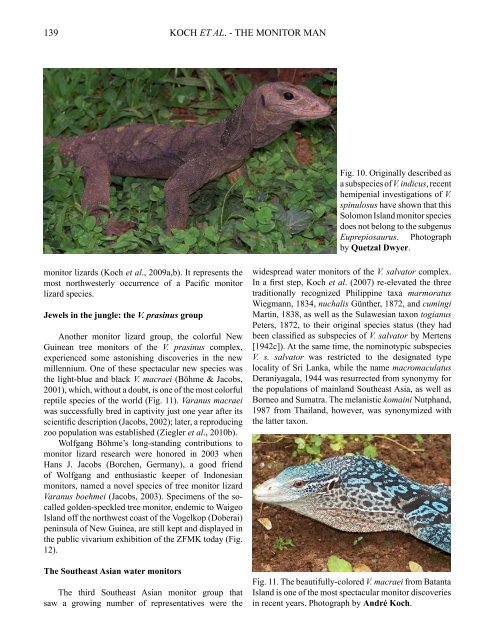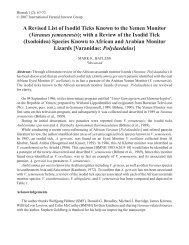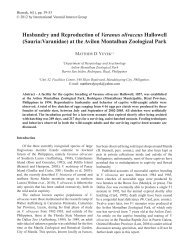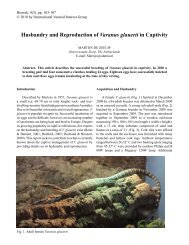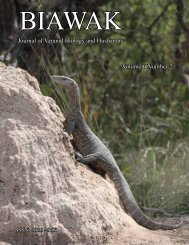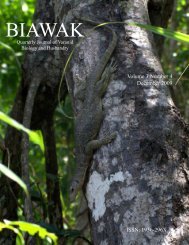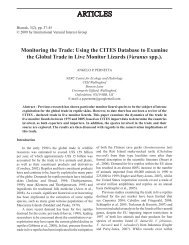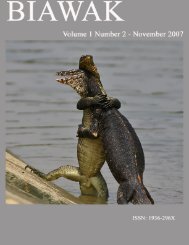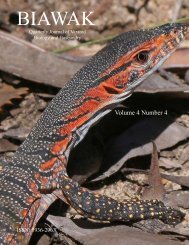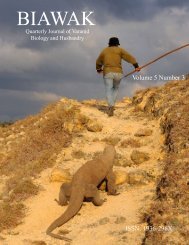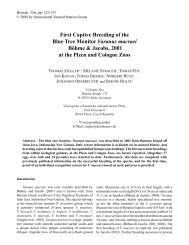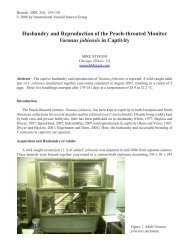BIAWAK - International Varanid Interest Group
BIAWAK - International Varanid Interest Group
BIAWAK - International Varanid Interest Group
- No tags were found...
You also want an ePaper? Increase the reach of your titles
YUMPU automatically turns print PDFs into web optimized ePapers that Google loves.
139<br />
KOCH ET AL. - THE MONITOR MAN<br />
Fig. 10. Originally described as<br />
a subspecies of V. indicus, recent<br />
hemipenial investigations of V.<br />
spinulosus have shown that this<br />
Solomon Island monitor species<br />
does not belong to the subgenus<br />
Euprepiosaurus. Photograph<br />
by Quetzal Dwyer.<br />
monitor lizards (Koch et al., 2009a,b). It represents the<br />
most northwesterly occurrence of a Pacific monitor<br />
lizard species.<br />
Jewels in the jungle: the V. prasinus group<br />
Another monitor lizard group, the colorful New<br />
Guinean tree monitors of the V. prasinus complex,<br />
experienced some astonishing discoveries in the new<br />
millennium. One of these spectacular new species was<br />
the light-blue and black V. macraei (Böhme & Jacobs,<br />
2001), which, without a doubt, is one of the most colorful<br />
reptile species of the world (Fig. 11). Varanus macraei<br />
was successfully bred in captivity just one year after its<br />
scientific description (Jacobs, 2002); later, a reproducing<br />
zoo population was established (Ziegler et al., 2010b).<br />
Wolfgang Böhme’s long-standing contributions to<br />
monitor lizard research were honored in 2003 when<br />
Hans J. Jacobs (Borchen, Germany), a good friend<br />
of Wolfgang and enthusiastic keeper of Indonesian<br />
monitors, named a novel species of tree monitor lizard<br />
Varanus boehmei (Jacobs, 2003). Specimens of the socalled<br />
golden-speckled tree monitor, endemic to Waigeo<br />
Island off the northwest coast of the Vogelkop (Doberai)<br />
peninsula of New Guinea, are still kept and displayed in<br />
the public vivarium exhibition of the ZFMK today (Fig.<br />
12).<br />
The Southeast Asian water monitors<br />
The third Southeast Asian monitor group that<br />
saw a growing number of representatives were the<br />
widespread water monitors of the V. salvator complex.<br />
In a first step, Koch et al. (2007) re-elevated the three<br />
traditionally recognized Philippine taxa marmoratus<br />
Wiegmann, 1834, nuchalis Günther, 1872, and cumingi<br />
Martin, 1838, as well as the Sulawesian taxon togianus<br />
Peters, 1872, to their original species status (they had<br />
been classified as subspecies of V. salvator by Mertens<br />
[1942c]). At the same time, the nominotypic subspecies<br />
V. s. salvator was restricted to the designated type<br />
locality of Sri Lanka, while the name macromaculatus<br />
Deraniyagala, 1944 was resurrected from synonymy for<br />
the populations of mainland Southeast Asia, as well as<br />
Borneo and Sumatra. The melanistic komaini Nutphand,<br />
1987 from Thailand, however, was synonymized with<br />
the latter taxon.<br />
Fig. 11. The beautifully-colored V. macraei from Batanta<br />
Island is one of the most spectacular monitor discoveries<br />
in recent years. Photograph by André Koch.


